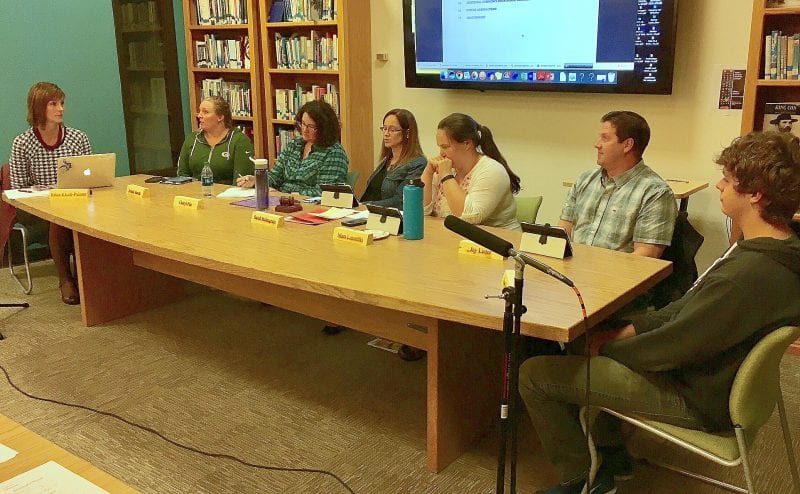
The Petersburg School District gathers Sept. 12 for a regular meeting to discuss testing at the schools. (Photo by Angela Denning/KFSK)
This past year was the first time that the state used the “Performance Evaluation for Alaska’s Schools” or PEAKs test for its statewide assessment test. It replaced the AMP (Alaska Measures of Progress) test that was tried a few years prior but had several technical problems.
When you look at the results from PEAKS, both statewide and in Petersburg, they don’t look that great.
“We were a little shocked on the math, if you’re looking at drilling down on the math…good grief,” said Petersburg Superintendent Erica Kludt-Painter.
The results show in Petersburg just 40 percent of students were proficient in math. And 55 percent of students were proficient in English language arts.
Petersburg’s test results were generally better than the state’s where about 68 percent of students were not proficient in math. About 62 percent of students in the state were not proficient in language arts.
Petersburg administrators have looked closer at some of the students’ performances and found questionable results. Kludt-Painter told the local school board that some students who scored high on math in the national PSAT test scored barely above proficient in PEAKS.
“So, we have to be reasonable about it is,” Kludt-Painter said. “You can’t have a kid be advanced on a PSAT or another national assessment and then show barely proficient on another one. That doesn’t jive. That doesn’t make sense.”
Kludt-Painter says the district has shared these thoughts with the test makers who are looking for feedback. The test was created by a mix of people from the test vendor, the Alaska Department of Education, and Alaska teachers.
So, what’s the take away from the PEAKS test results? Kludt-Painter says to keep it in perspective. It’s the first year of the test, a baseline year or what they call an “indicator”. The schools had about four months to prepare and they didn’t have any practice tests.
But at the same time, it’s important to test students every year, she says. It gives the district and its teachers direction.
“Of course we can always do better, we should always be striving to look at what we can do to improve instruction. Always,” Kludt-Painter said. So, that’s what we all take from it.”
She says PEAKS is just one piece of a student’s profile.
And soon in Petersburg, there will be another piece… the MAP test. MAP stands for Measures of Academic Progress. The Petersburg district plans to use the test on all kindergarten through 10th graders three times this year. That way they’ll get a good picture of where individual students are at.
Petersburg’s Testing Coordinator, Bridgett Wittstock, says they want to use MAP because nearly all school districts in the state do.
“It’s a better way to measure progress and to show growth over time as well as help us understand where kids are at,” Wittstock said. “Whether or not they are at grade level, below grade level, or above grade level.
So why the two tests? MAP and PEAKS…If nearly all the districts use MAP, why doesn’t the state use it for the mandatory standardized test? Wittstock says they’re two different types of tests—MAP is formative, PEAKs is summative, and the district needs them both. The PEAKs test is the same across the board for each grade. But the MAP test challenges individual students as they go along, allowing them to answer more questions until they hit a ceiling.
“And so it’s pretty cool,” Wittstock said. “It’s not just like a grade level test and at grade level you get it done really quick. Actually, if you’re not at grade level it may take you a little longer because it’s going to be more challenging.”
Superintendent Kludt-Painter says the district has had different tests at different schools over the years. But MAP will be a consistent measurement of a student’s progress throughout their whole school career.
“Again, not that we’re all about testing or we’re so excited about testing,” Kludt-Painter said. “But to have kids understand where they are as well and to be able to see their growth and to be able to actually talk about it from kindergarten through 10th grade, we’ve not had a continuous way of having that conversation.”
The MAP testing is happening right now for students at the elementary school. Teachers hope to have the results shortly after the two week testing window is over.









